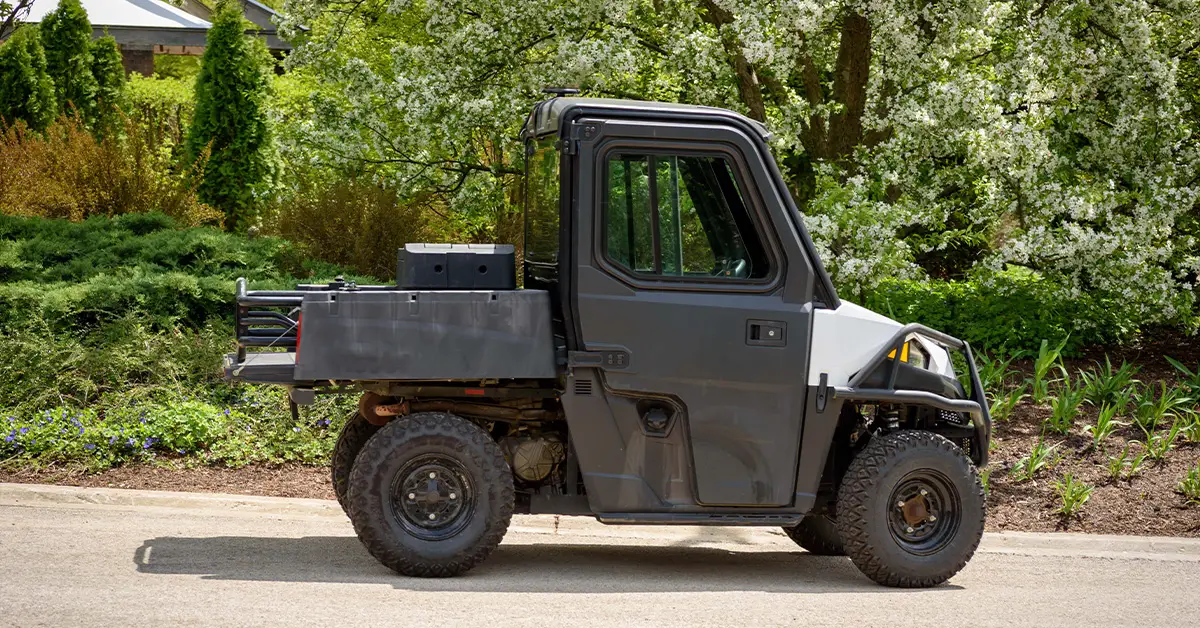All vehicles, not just UTVs, require proper maintenance to operate safely and extend their mechanical life. Appropriate UTV storage is part of that crucial process to keep your vehicle in peak condition.
But can you keep a UTV outside at the end of the riding season?
You can store your UTV outdoors all year around. If you are planning on leaving your side-by-side or SxS sitting outside for an extended period, you must implement strategies to protect it. Otherwise, you will expose your UTV to harsh weather and other elements that can contribute to unnecessary wear and tear.
You can refer to the user manual for outdoor UTV storage ideas. In this post, though, we will share general tips for storing your UTV and how to care for it while it is in storage.
Table of Contents
How to Properly Store Your UTV Outside
Even if provided with the right storage solutions, leaving your SxS covered in mud can cause issues, such as rusting and contamination.
Therefore, when you are ready to store your utility terrain vehicle, clean it inside and out. As part of the process, remember to clean the air filter and the inside of the filter box.
Once your UTV is clean and dry, consider the following tips to prevent deterioration and damage to your vehicle while in storage.
1. Cover your UTV
One of the effective ways to protect your machine is to invest in a heavy-duty UTV cover.
The UV rays on your UTV could be highly damaging and lead to tire dry rotting. These rays break down the rubber compounds, causing premature aging. Also, the heat from the sun evaporates the battery fluid, shortening the battery lifespan.
A high-quality UTV cover can guard your system against harsh weather, pollutants, dirt, debris, dust, and many other damaging elements.
It is crucial that the cover also allows the moisture that builds up underneath your UTV to evaporate and avoid corrosion or oxidation.
As such, stay away from coated or plastic machine covers. Fortunately, most covers you will find in the market are made from breathable materials. But, of course, make an effort to verify this when you buy the UTV cover.
2. Choose the storage area carefully
In outdoor storage, vehicles are best stored where there is good drainage. You can cover your UTV, but water can collect and pool around the machine. While tires are waterproof, keeping them submerged in a puddle of water is not recommended. In an extreme case, that standing water can cause problems to your braking or suspension system due to metal rusting.
And even if the storage area allows good drainage, it is best to set and safely support your side-by-side with the tires 25-50 mm off the ground.
Doing this help prevents tire deformation. Yes, leaving your SxS standing on the same point for an extended period often leads to flat spots. You are bound to experience annoying vibrations when you take your UTV out of storage for a ride.
Suppose you lack the tools to lift the vehicle off the ground. Try to keep the tires inflated with the recommended pressure level. Also, consider frequently turning the wheels to avoid distortion.
3. Fill the gas tank
If your UTV will remain in storage for over 30 days, the best course of action is to top off the tank. Failure to do this, you will leave space that promotes the buildup of condensation inside the fuel tank. Unfortunately, this can bring about rust problems.
For an added layer of protection, consider adding a fuel stabilizer to your gasoline. A fuel stabilizer prevents the deterioration of gas, an issue that could otherwise lead to ethanol separation. Ethanol can eat away the surfaces of metals and plastics of the fuel system parts.
4. Empty oil from your vehicle
Used engine oil could spell trouble for your vehicle if it remains unoperated for more than 30 days. Exposure to freezing temperatures makes the UTV oil thicken. Also, the motor oil contains contaminants (acids and combustion by-products), posing a threat to your engine.
5. Remove the UTV battery
The battery loses juice when you don’t drive your side-by-side. The last thing you want is your vehicle refusing to start because the battery is dead.
A simple UTV winter storage trick that could help preserve your battery is to — disconnect the battery, charge it, and store it in a warm, dry place. Still, you will need to charge it periodically.
Another option involves using a battery maintainer. It is a charging device that works by delivering just enough energy to your SxS battery to keep it at full charge. The device tops off the energy charge in small amounts.
6. Apply grease where applicable
Lubricating the exposed piston rods and moving parts of your vehicle is crucial to prevent rusting, which increases part wear and tear.
7. Check all fluid levels
Another best practice to keep a UTV outside without unnecessary wear is to fill up all the vehicle fluid. Check the power steering fluid, transmission fluid, brake fluid, etc. Top up as needed.
You also need to pay attention to coolant conditions. The coolant helps regulate your engine when exposed to extreme temperatures, preventing rusting on the inside. It is a colored liquid mixed with water. Make sure it is not only water in the antifreeze.
8. Seal openings
Weather elements are not the only culprits in damaging your UTV in outdoor storage. You must also protect your vehicle from rodents seeking a warm, dry home when temperatures drop below freezing point.
In line with that, make sure to cover the tailpipes, pipes, and other openings with a cloth, aluminum foil, or tape. Don’t leave any potential entry. The unwelcomed creatures can chew wires, damage fabrics, and nest in the air filter.
9. Operate your UTV often
We have heard stories of UTV owners doing everything right but got shocked to learn their machines could not start at the end of the storage season. Why — because they failed to warm their UTVs regularly.
The rule of thumb is to operate your vehicle at least each week. Install a charged battery. Then, start the UTV engine and leave it powered for about 10 to 15 minutes.
It helps keep the engine and other components adequately lubricated. It will also prevent corrosion in confined spaces of the engine and hydraulic system.
10. Don’t use the parking brake
Activating the parking brake may seem the most logical thing to do. However, if your machine stays in storage with the parking brakes on, it means the brake pads will make contact with the rotors all through.
Unfortunately, this can lead to fusing. You will want to buy a chock or tire stopper to avoid subjecting your brake pads to unnecessary pressure.
How to Prepare Your UTV for Use After Outdoor Storage
After a long period in storage, you need to take safety precautions before you start riding your side-by-side. Here is a checklist of what to do when it is time to get back in action:
· Inspect all parts: Ensure everything is working as designed. We mean the steering and drive system, throttle and brake control system, lights, wheels, suspension, muffler, air filter, spark plugs, etc.
· Reconnect the battery: If you disconnected your UTV battery and have been charging it periodically, install it back. If you left it in place with a battery maintainer, test it before hooking it back and starting the engine.
· Check fluid levels: While you might have followed all the safety measures, problems that lead to leaks can arise. For example, rodents could be to blame for some of the fluid leaks in UTVs in storage. Check while the engine is off. Then, top up the fluids if necessary.
· Check the antifreeze in the overflow bottle: Replace the coolant level if needed. If you notice the coolant is sludgy and oily, it is safe to have your mechanic inspect it.
· Examine the air filter housing and filter: Small insects can find a way into the filter housing. Ensure there are no nests in there for a clean run. If damaged, replace it.
· Warm your UTV engine: After letting your engine run for a couple of minutes, consider changing the engine oil and oil filter.
· Inspect all cables and lubricate them: Carefully scan the cables to ensure no damage. Lubricate them and other rolling parts to reduce friction that might contribute to wear and tear.
· Inspect the alternator drive belt tension. Remove the ignition key before checking the belt tension. Look around the belt. Replace if you spot cracks, tears, scuffs, or bumps.
· Tighten up: Check any loose nuts, bolts, screws, or cap screws and tighten them properly.
· Adjust tire pressure: Check tire pressure and inflate the tire to the right level.
If this seems like a lot of work you cannot handle, we recommend leaving the task to a mechanic you trust. Don’t take chances. As we wrap up, we cannot put enough emphasis on proper UTV storage if you intend to keep your vehicle outside.
Your actions can protect your SxS and save you from unnecessary repairs and replacements. Perhaps increasing your safety behind the wheel is the most important reason not to overlook your UTV storage.







